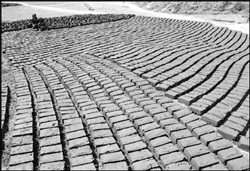 A long the ridge to the south of the picturesque village of Bungamati, you come to an area where previously there had been layers of fan shaped rice terraces and trees descending towards the Bagmati River. Today, there are sterile grey-brown bricks, lined up like wooden soldiers across the mutilated dead fields bereft of their topsoil.
A long the ridge to the south of the picturesque village of Bungamati, you come to an area where previously there had been layers of fan shaped rice terraces and trees descending towards the Bagmati River. Today, there are sterile grey-brown bricks, lined up like wooden soldiers across the mutilated dead fields bereft of their topsoil. Slap, bang, slop came the sounds of teams of men beating out more bricks to join the rest. I stood in horror at the sight of the destruction of yet more of the fertile Kathmandu Valley soil. These fields have faithfully fed families for generations, it is now being sold to some big shot brick company. In just a few weeks the beauty and fertility will all be gone. How is Nepal to feed her growing population?
People need food, clothes, services. To purchase those, they need land or jobs. Work on the land is hard, but worse are many of the other options open to poor people - the carpet factories, street life, migration to India or the Gulf. At least working the land gives some measure of security and dignity, a quality of life (provided the air is not polluted by a brick kiln next door). This must be preferable to miserably paid labour (or no job) in an expensive city. Those who work the land often may not own it. They work for the landowner, and are able to keep only a proportion of the crop. But they are in an even worse position when it comes to getting jobs elsewhere, at the bottom of the economic heap as the landless poor.
You cannot stop development. But there has to be regulation and control, with due thought given to environmental factors. Development must be planned, and decisions taken which minimise the damage to the environment and maximise the potential of Nepal's limited resources. Making bricks is very poor use of good land, a one-off harvest, which benefits only one entrepreneur. It is reckoned that in 25 years there will be no agricultural land left in the Kathmandu Valley, which has a civilisation that grew from the fertility of its soil and the hard-working farmers who tilled it.
The physical limitation imposed on the Valley by its size, water supply and the pollution-trapping characteristic of its topography means we are already exceeding the limits to its growth. The fertile soil left by the original lake should be used as much as possible for agricultural purposes. Alas, we are sending it up in smoke.
Born in England at the beginning of the 1950s I grew up watching the results of the unthinking and unregulated development that followed the second world war. In the 1960s and 70s, many of us awoke to the fact that this craziness had to stop. The industrialists, moneymakers and politicians ridiculed our protests, telling us to "get real" and accept that pollution and environmental destruction were the price we had to pay for modern life. Nepal has a chance to learn from the expensive mistakes we in the west made. Please take the opportunity, before it is too late.
There are signs of popular resistance. Residents of Bhaktapur recently attacked and damaged brick kilns, which were illegal and polluting their homes. If the system fails, then people take up matters into their own hands so that a selfish few don't grab what belongs to everyone.
(Cherry Bird is researching environmental education in Nepal, and has lived here for five years.)


